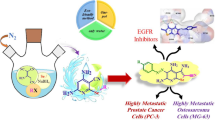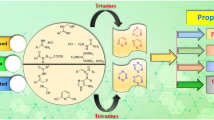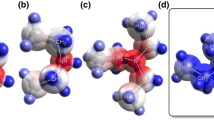Abstract
Two thiacalix[4]arenes in 1,3-alternate conformation functionalized by two (CH2)2NH(C=X)NHC6H4-NO2-p groups (X = S,O) as well as two related monofunctional receptors MeO(CH2)2NH(C=X)NHC6H4-NO2-p were prepared and characterized by X-ray crystal structures. The thioureido and ureido derivatives have E,Z and E,E conformations respectively both in monofunctional receptors and thiacalixarenes. The thiacalixarene attached thiourea groups are well separated from each other, but respective urea groups are much closer to each other and have mutual parallel orientation making the bisurea derivative a better preorganized receptor as compared to bisthiourea. Binding of Cl−, F−, H2PO4 − and AcO− anions in chloroform and DMSO was studied by spectrophotometric and NMR titrations. In chloroform both bisurea and bisthiourea thiacalix[4]arenes bind anions 3–5 times stronger than corresponding monofunctional compounds in spite of better preorganization of the urea derivative. In DMSO simultaneous deprotonation of ureido NH groups of receptors and hydrogen bonding reactions are observed. Deprotonation by H2PO4 − is accompanied by a strong association between liberated H3PO4 and H2PO4 − (log K = 3.9). For hydrogen bonding associations the binding constants of H2PO4 − and AcO− with bisurea thiacalixarene are up to two orders of magnitude larger than those with corresponding monofunctional receptor, but with bisthiourea thiacalixarene the effect is less than two-fold. Thus in this solvent in contrast to chloroform the preorganization is an important factor.











Similar content being viewed by others
References
Gale, P.A., García-Garrido, S.E., Garric, J.: Anion receptors based on organic frameworks: highlights from 2005 and 2006. Chem. Soc. Rev. 37, 151–190 (2008). Reviews
Bates, G.W., Gale, P.A.: An introduction to anion receptors based on organic frameworks. Struct. Bond 129, 1–44 (2008)
Steed, J.W.: A modular approach to anion binding podands: adaptability in design and synthesis leads to adaptability in properties. Chem. Commun. 2637–2649 (2006)
Amendola, V., Bonizzoni, M., Esteban-Gómez, D., Fabbrizzi, L., Licchelli, M., Sancenón, F., Taglietti, A.: Some guidelines for the design of anion receptors. Coord. Chem. Rev. 250, 1451–1470 (2006)
Kang, S.O., Begum, R.A., Bowman-James, K.: Amide-based ligands for anion coordination. Angew. Chem. Int. Ed. 45, 7882–7894 (2006)
Sessler, J.L., Gale, P.A., Cho, W.-S.: Anion Receptor Chemistry. Royal Society of Chemistry, Cambridge, UK (2006)
Leung, A.N., Degenhardt, D.A., Bühlmann, P.: Effect of spacer geometry on oxoanion binding by bis- and tetrakis-thiourea hosts. Tetrahedron 64, 2530–2536 (2008)
Lowe, A.J., Dyson, G.A., Pfeffer, F.M.: Steric and electronic factors influencing recognition by a simple, charge neutral norbornene based anion receptor. Org. Biomol. Chem. 5, 1343–1346 (2007)
Rashdan, S., Light, M.E., Kilburn, J.D.: Pyridyl thioureas as switchable anion receptors. Chem. Commun. 4578–4580 (2006)
Snellink-Ruël, B.H.M., Antonisse, M.M.G., Engbersen, J.F.J., Timmerman, P., Reinhoudt, D.N.: Neutral anion receptors with multiple urea-binding sites. Eur. J. Org. Chem. 165–170 (2000)
Turner, D.R., Paterson, M.J., Steed, J.W.: A conformationally flexible, urea-based tripodal anion receptor: solid-state, solution, and theoretical studies. J. Org. Chem. 71, 1598–1608 (2006)
Scheerder, J., Fochi, M., Engbersen, J.F.J., Reinhoudt, D.N.: Urea-derivatized p-tert-butylcalix[4]arenes: neutral ligands for selective anion complexation. J. Org. Chem. 59, 7815–7820 (1994)
Lhoták, P.: Anion receptors based on calixarenes. Top. Curr. Chem. 255, 65 (2005)
Schazmann, B., Alhashimy, N., Diamond, D.J.: Chloride selective calix[4]arene optical sensor combining urea functionality with pyrene excimer transduction. Am. Chem. Soc. 128, 8607–8614 (2006)
Nabeshima, T., Saiki, T., Iwabuchi, J., Akine, S.J.: Stepwise and dramatic enhancement of anion recognition with a triple-site receptor based on the calix[4]arene framework using two different cationic effectors. Am. Chem. Soc. 127, 5507–5511 (2005)
Yakovenko, A.V., Boyko, V.I., Kalchenko, V.I., Baldini, L., Casnati, A., Sansone, F., Ungaro, R.J.: N-linked peptidocalix[4]arene bisureas as enantioselective receptors for amino acid derivatives. Org. Chem. 72, 3223–3231 (2007)
Curinova, P., Stibor, I., Budka, J., Sykora, J., Lang, K., Lhotak, P.: Anion recognition by diureido-calix[4]arenes in the 1,3-alternate conformation. New J. Chem. 33, 612–619 (2009)
Sasaki, S., Mizuno, M., Naemura, K., Tobe, Y.J.: Synthesis and anion-selective complexation of cyclophane-based cyclic thioureas. Org. Chem. 65, 275–283 (2000)
Okumura, Y., Murakami, S., Maeda, H., Matsumura, N., Mizuno, K.: Synthesis and dual binding character of novel macrocyclic thiourea derivatives. Tetrahedron Lett. 44, 8183–8185 (2003)
Roussel, C., Roman, M., Andreoli, F., Del Rio, A., Faure, R., Vanthuyne, N.: Non-racemic atropisomeric (thio)ureas as neutral enantioselective anion receptors for amino-acid derivatives: origin of smaller Kass with thiourea than urea derivatives. Chirality 18, 762–771 (2006)
Lhoták, P., Svoboda, J., Stibor, I.: Anion receptors based on ureido-thiacalix[4]arenes. Tetrahedron 62, 1253–1257 (2006)
Zlatušková, P., Stibor, I., Tkadlecová, M., Lhoták, P.: Novel anion receptors based on thiacalix[4]arene derivatives. Tetrahedron 60, 11383–11390 (2004)
Kroupa, J., Stibor, I., Pojarova, M., Tkadlecova, M., Lhotak, P.: Anion receptors based on ureido-substituted thiacalix[4]arenes and calix[4]arenes. Tetrahedron 64, 10075–10079 (2008)
Morohashi, N., Narumi, F., Iki, N., Hattori, T., Miyano, S.: Thiacalixarenes. Chem. Rev. 106, 5291–5316 (2006)
Lhotak, P.: Chemistry of thiacalixarenes. Eur. J. Org. Chem. 1675–1692 (2004)
Iki, N.: Non-covalent strategy for activating separation and detection functionality by use of the multifunctional host molecule thiacalixarene. J. Incl. Phenom. Macrocycl. Chem. 64, 1–13 (2009)
Yamato, T., Perez-Casas, C., Elsegood, M.R.J., Dale, S.H., Redshaw, C.: Synthesis and inclusion properties of a novel thiacalix[4]arene-based hard-soft receptor with 1,3-alternate conformation. J. Incl. Phenom. Macrocycl. Chem. 55, 31–36 (2006)
Liu, L., Huang, K., Yan, C.G.: Syntheses, reactions and crystal structures of 1,3-alternate p-tert-butylthiacalix[4]arene esters and amides. J. Incl. Phenom. Macrocycl. Chem. (2009) doi:10.1007/s10847-009-9652-4
Schneider, H.-J., Yatsimirsky, A.K.: Selectivity in supramolecular host–guest complexes. Chem. Soc. Rev. 37, 263–277 (2008)
Kumagi, H., Hasegawa, M., Miyanari, S., Sugawa, Y., Sato, Y., Hori, T., Udea, S., Kamiyama, H., Miyano, S.: Facile synthesis of p-tert-butylthiacalix[4]arene by the reaction of p-tert-butylphenol with elemental sulfur in the presence of a base. Tetrahedron Lett. 38, 3971–3972 (1997)
Pérez-Casas, C., Yamamoto, H., Yamato, T.: Regioselective synthesis of distal-bisalkoxytetrathiacalix[4]arenes by a protection-deprotection method using benzyl groups. J. Chem. Res. 694–696 (2005)
Pescatori, L., Arduini, A., Pochini, A., Ugozzoli, F., Secchi, A.: Design, synthesis and recognition properties of urea-type anion receptors in low polar media. Eur. J. Org. Chem. 109–120 (2008)
Hamon, M., Ménand, M., Le Gac, S., Luhmer, M., Dalla, V., Jabin, I.J.: Calix[6]tris(thio)ureas: heteroditopic receptors for the cooperative binding of organic ion pairs. Org. Chem. 73, 7067–7071 (2008)
Pérez-Casas, C., Yatsimirsky, A.K.: Detailing hydrogen bonding and deprotonation equilibria between anions and urea/thiourea derivatives. J. Org. Chem. 73, 2275–2284 (2008)
Amendola, V., Esteban-Gómez, D., Fabbrizzi, L., Licchelli, M.: What anions do to N-H-containing receptors. Acc. Chem. Res. 39, 343–353 (2006)
Boiocchi, M., Del Boca, L., Esteban-Gómez, D., Fabbrizzi, L., Licchelli, M., Monzani, E.: Nature of urea-fluoride interaction: incipient and definitive proton transfer. J. Am. Chem. Soc. 126, 16507–16514 (2004)
Boiocchi, M., Del Boca, L., Esteban-Gómez, D., Fabbrizzi, L., Licchelli, M., Monzani, E.: Anion-induced urea deprotonation. Chem. Eur. J. 11, 3097–3104 (2005)
Esteban-Gómez, D., Fabbrizzi, L., Licchelli, M.: Why, on interaction of urea-based receptors with fluoride, beautiful colors develop. J. Org. Chem. 70, 5717–5720 (2005)
Bordwell, F.G.: Equilibrium acidities in dimethyl sulfoxide solution. Acc. Chem. Res. 21, 456–463 (1988)
Elmore, K.L., Hartfield, J.D., Dunn, R.L., Jones, A.D.: Dissociation of phosphoric acid solutions at 25. J. Phys. Chem. 69, 3520–3525 (1965)
Braga, D., Curzi, M., Maini, L., Polito, M., Grepioni, F.: Crystal synthesis of hybrid organometallic-inorganic hydrogen bonded salts of acid oxoanions. Dalton Trans. 2432–2437 (2004)
Formica, M., Fusi, V., Macedi, E., Paoli, P., Piersanti, G., Rossi, P., Zappiac, G., Orlando, P.: New branched macrocyclic ligand and its side-arm, two urea-based receptors for anions: synthesis, binding studies and crystal structure. New J. Chem. 32, 1204–1214 (2008)
Bruker Analytical X-ray Systems, SMART: Bruker Molecular Analysis Research Tool, Versions 5.057 and 5.618, (1997) and (2000)
Bruker Analytical X-ray Systems, SAINT + NT, Versions 6.01 and 6.04, (1999) and (2001)
Sheldrick, G.M.: SHELX-86, Program for Crystal Structure Solution. University of Göttingen, Germany (1986)
Bruker Analytical X-ray Systems, SHELXTL-NT Versions 5.10 and 6.10, (1999) and (2000)
Acknowledgments
Carol Pérez-Casas thanks DGAPA UNAM and CONACyT for the postdoctoral fellowships and Anatoly Yatsimirsky thanks DGAPA UNAM for Sabbatical fellowship.
Author information
Authors and Affiliations
Corresponding author
Electronic supplementary material
Below is the link to the electronic supplementary material.
Rights and permissions
About this article
Cite this article
Pérez-Casas, C., Höpfl, H. & Yatsimirsky, A.K. Structures of urea/thiourea 1,3-disubstituted thia[4]calixarenes and corresponding monofunctional receptors and their anion recognition properties. J Incl Phenom Macrocycl Chem 68, 387–398 (2010). https://doi.org/10.1007/s10847-010-9798-0
Received:
Accepted:
Published:
Issue Date:
DOI: https://doi.org/10.1007/s10847-010-9798-0




